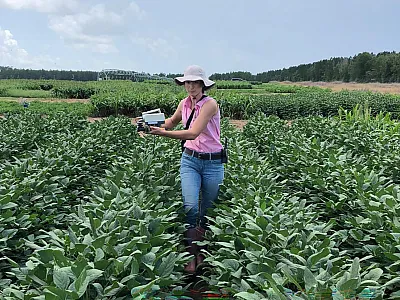Maintaining in a Changing Climate TURF
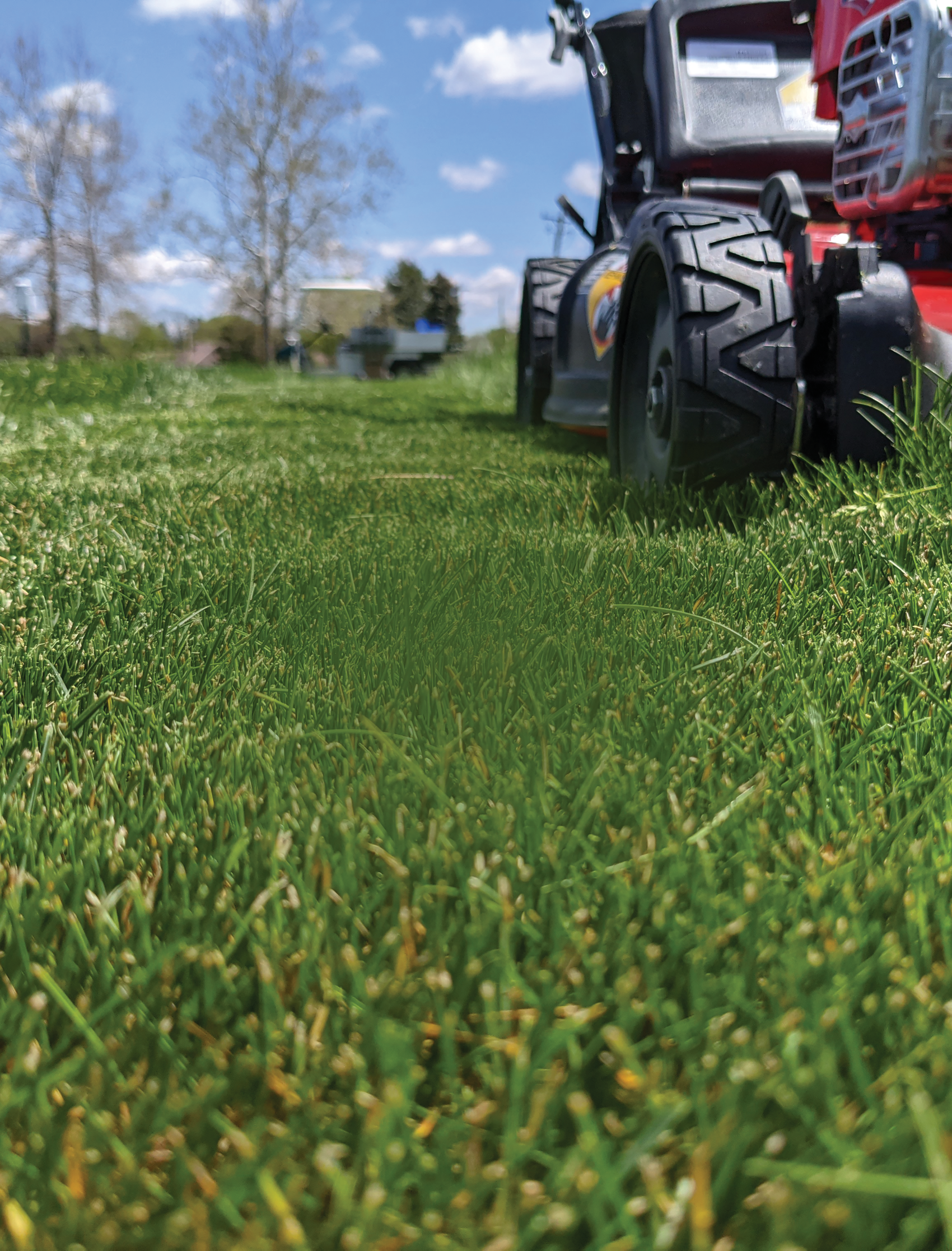
Turfgrass, the biggest crop in the United States, is also among the most hotly debated. Whether you’re a lover or a hater, the fact remains that those tens of millions of green acres result in large amounts of greenhouse gas emissions while also sequestering tons of carbon. Turfgrass scientists are exploring how everyone from homeowners to golf course superintendents can boost turf’s benefits while minimizing its environmental footprint.
Turfgrass, the biggest crop in the United States, is also among the most hotly debated. Whether you’re a lover or a hater, the fact remains that those tens of millions of green acres result in large amounts of greenhouse gas emissions while also sequestering tons of carbon. Turfgrass scientists are exploring how everyone from homeowners to golf course superintendents can boost turf’s benefits while minimizing its environmental footprint.
As a University of Connecticut grad student 20‐odd years ago, Kelly Kopp was contentedly studying hydrology, focusing on how the herbicide atrazine moves in the soils of corn fields. She took pride in working on an important source of livestock feed, fuel, and human food, grown across tens of millions of acres in the U.S. Then a member of her master’s committee proposed a career shift, inviting her to join his recently funded project on—of all things—turfgrass.
“I looked at him like he was out of his mind,” recalls Kopp, now a professor and extension specialist in the Plants, Soils & Climate Department at Utah State University. “I thought: Why on earth would I switch from production agriculture to this—this plant material that, as far as I could see, is not really doing a whole heck of a lot for anybody?”
In the end, the professor persuaded Kopp that, given how much land turfgrass covers in the country—three times as much as corn, according to estimates—their work would have high impact. Today Kopp, a member of all three Societies, spends much of her time not only educating people on the proper care of turfgrass, but taking on skeptics who, like her younger self, see scant value in the stuff. With climate change on everyone’s mind, she fields more frequent and pointed questions on turfgrass’s utility, its carbon footprint, how it stacks up against alternative plantings. “There’s been a real target put on turfgrass,” Kopp says.
Indeed, with global warming, some experts say the less turfgrass the better; an active anti‐lawn movement advocates for native, pollinator‐friendly, low‐maintenance alternatives. But while turf has environmental downsides, it also, as outlined in a recent Crop, Forage & Turfgrass Management (CFTM) paper (https://doi.org/10.1002/cft2.20218), provides significant benefits. In addition, improved management practices and varieties are leading to a better balance of ecosystem services and disservices. The bottom line, according to lead author Ross Braun: We should continue to golf, picnic, and take pride in our front lawns. We just need to be smarter about it.
“There are a lot of things a practitioner can do,” says Braun, a CSSA and ASA member and assistant professor of turfgrass and landscape management at Kansas State University. His paper, as much a how‐to on climate‐smart turf management as a review of recent literature, lists dozens of strategies related to mowing, fertilization, irrigation, and other practices. In this story, we’ll walk through some of them, starting with a dip into irrigation.

Turf Nation
Although “turfgrass” may bring highly manicured golf courses to mind, it is by no means all fairways and putting greens. It covers city parks, campuses, roadsides, sports fields, sod farms, and millions of homeowner lawns. That adds up to a lot of groundcover. In one oft‐cited Environmental Management study from 2005, researchers using a model estimated that turfgrass covers 1.7% of the contiguous United States—some 40 million acres. North Carolina State University’s Department of Crop and Soil Sciences puts the country’s total managed turf at 50 million acres.
It’s not clear exactly how that breaks down by use. However, a 2023 report by the Golf Course Superintendents Association of America (GCSAA) fills in one piece of the puzzle, tallying the acreage devoted to golf courses in the U.S. at just 2.1 million (a drop from 2005), about 1.3 million of it managed turf.
Still, golf courses are a big part of the conversation on turf management, including water. They use a lot of it, fund a lot of research on the topic, and devote significant resources to curbing their water bills. A GCSAA report on water use on the nation’s fairways provides some insights. Based on a survey of superintendents, researchers determined that golf courses used about 551 billion gallons for irrigation in 2020 with the median applied water per facility at about 21.6 million gallons. The good news: Usage dipped 29% since 2005 due both to course closures and less water applied per acre. However, median total irrigated acres increased 10%. Reducing irrigation on the roughs would help conserve more water, the report notes.
Most of us don’t manage golf courses, but many of us do manage yards. And when we water them, it adds up fast. A 2016 study by the Water Research Foundation that examined U.S. households with lawns found they used an average of 100,000 gallons annually, half of it on the landscape. While most applied appropriate amounts, 13% watered too heavily, some by a lot, according to the study: If that were corrected, average outdoor use would drop by 16%.
Saving at the Spigot
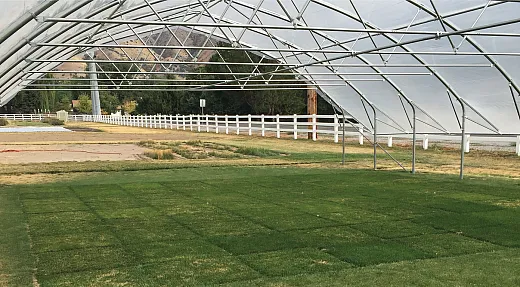
In large part to conserve water, property owners and golf courses are under pressure to rethink their use of turf. The USEPA’s WaterSense program advocates for “water‐smart landscaping,” such as planting turf only where it has a practical function, such as play areas. California provides homeowners financial incentives to eschew grass in favor of drought‐tolerant plants. Utah legislators have sought to require golf courses to publish water usage while companies are digging up the turf on their grounds and replacing it with prairies and pollinator‐friendly plants.
Climate change’s effects on temperature, solar radiation, and wind will impact evapotranspiration rates, making wise water use more important in turfgrass systems, Braun’s article points out. Professional managers of large turf areas can more easily implement water‐saving strategies listed in Braun’s CFTM review, such as tapping into harvested rainwater and non‐potable water, aerating the soil, and leveraging GPS technologies to identify and target areas for precision management.
The amateurs, though, often misread their home lawns. According to studies cited by the USEPA, half of the water Americans use outdoors goes to waste from evaporation, wind, or runoff due to overwatering. Every summer, Utah State University Extension fields hundreds of frantic phone calls. “People are panicking because their lawn is going dormant, and they think it’s dying,” Kopp says. It’s like leaves dropping from trees every fall, she tells callers: a natural and temporary response to changing seasons.
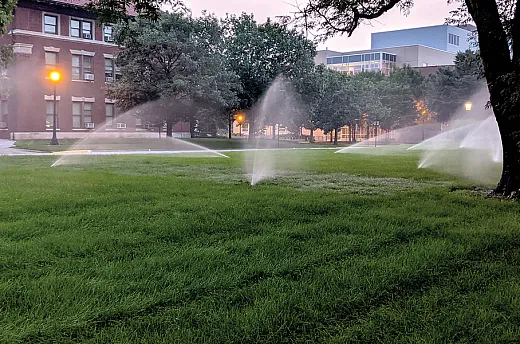
Waste is not the only downside to overwatering. Wetter soils convert more soil nitrate into dinitrogen gas, which can lead to more nitrous oxide (N2O) being released. Braun urges people to exercise restraint at the spigot. In a 2018 Crop Science article, he reported that cutting summertime turfgrass irrigation lowered cumulative N2O emissions by 6%.
While irrigation systems theoretically mean more efficient watering, they can make it too easy to overwater. “It’s a whole different ballgame when somebody can just hit a button and their whole sprinkler system goes off and they’re using 3,000 gallons in 15 minutes,” Kopp says. Also, a household with an improperly maintained or operated automatic irrigation system can waste up to 25,000 gallons of water annually.
If you really need an irrigation system, keep it efficient with yearly maintenance, and make it smart by pairing it with a controller that automatically adjusts for weather. In her research, Kopp has seen water use drop by half with such smart technologies. Also, newer varieties of turfgrass need less water.
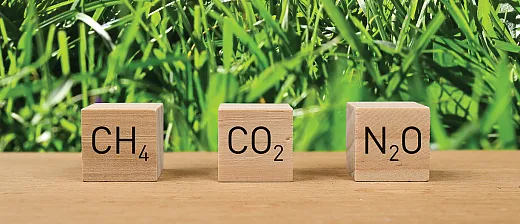
“Incredible breeding work has brought to us much lower water‐use varieties of these grasses and varieties that don’t need as much nutrition—varieties that maintain color under very challenging traffic conditions,” Kopp says.
Turf and Carbon
Turf’s environmental cost can be higher than it first appears, Braun points out in the 2023 CFTM paper. Activities that occur on the golf course itself—burning gasoline in mowers, for example—are obvious carbon emitters. But when calculating total impact, it’s equally important to include emissions produced off‐site but used on‐site, such as electricity, and those both produced and used off‐site yet related to on‐site activities, such as emissions from upstream supply chains.
Braun and his coauthors collected calculations from a dozen studies of carbon sequestration rates of home lawns, golf courses, and grasslands. Most did not factor in hidden costs, and assessments varied significantly. One study for home lawns put the low end of carbon sequestration at 0.08 tons of carbon per acre per year while another put the high end at 1.25. For golf courses, studies that ignored hidden costs estimated rates as low as 0.1 tons and as high as 1.58 tons. Only a few studies factored in hidden costs, including one co‐authored by Braun that put the range for golf courses at 0.18–0.27 tons.
While the range of results underscores the challenges of carbon accounting, there’s another important message in the numbers, Braun says: Carbon sequestration rates for managed turf are in the same ballpark as those for natural grasslands, which range from –1.03 tons for some fire‐maintained systems to 0.49 tons for established grasslands.
“What this is trying to show is that turfgrass systems, regardless of whether they are golf courses or home lawns, have similar or better numbers for carbon sequestration as grassland that’s not being mowed,” Braun says. “We can get just as much carbon sequestered in a turfgrass system.”
That’s not always the case, Braun adds. “Obviously a more highly managed system with more inputs, that’s going to have more hidden carbon costs.”
Want to know how management affects GHG emissions at your home, office, or city park? Pamela Conrad has an app for that. Conrad is the founder of Climate Positive Design, an organization that promotes sustainable landscape design. While most GHG emissions related to her profession pertain to material choices—crushed rock is more climate‐friendly than concrete, for example—plant choices also play a big role, including how much space is devoted to turf and how it’s managed. With plants, Conrad points out, carbon sequestration is all about biomass. Think of big trees like sequoias as a gold standard, followed by, in order of declining carbon storage, understory trees, woody shrubs, and turfgrass.
To help people calculate the environmental impact of their landscape choices, Conrad three years ago launched an app called Pathfinder. Designed for professionals, the tool is free to all (those using it for academic, personal, or testing purposes should tick a box when they register to exclude their data from the app’s database). A homeowner can use the app, for example, to see how managing a half‐acre lawn affects global warming, based on data from a 2015 Journal of Environmental Management study. If managed intensively (mowing, irrigation, and intense use of non‐organic fertilizer), that green patch of the American dream will generate about 20,000 kg a year of emissions. Moderate and minimal management result in progressively lower emissions. For a net positive effect, you need to go no‐mow (no mowing or irrigation and use of organic fertilizer), which would sequester about 80,000 kg annually.
The beautiful, emerald‐green front yard, “has a certain kind of stature in this country,” Conrad says. But, she adds, “Even though it looks green, it’s maybe not, for the environment.” Still, landscape choices depend on how a site will be used. “Not everywhere is it possible to have a meadow or a no‐mow grass situation,” Conrad says.
Golf courses, for example, are by nature highly managed. That makes those management choices all the more impactful. In Singapore earlier this year, one golf course reportedly became the first to achieve carbon neutrality.
The range of strategies to reduce turf’s greenhouse gas (GHG) emissions can be overwhelming, says Braun. “Look at one thing at a time and slowly start to adopt,” he advises, “then build off that.” Let’s look at some options from his 2023 CFTM paper.
Managing for Greenhouse Gases
The three main GHG are, of course, carbon dioxide (CO2), N2O, and methane (CH4). While CO2 and N2O have more obvious connections to turfgrass management, CH4 has received little attention, a gap scientists need to fill, Braun notes.
More scrutiny should also be given to N2O. Despite its potency as a GHG (pound for pound, its global warming impact is 265 times that of CO2), most studies of turfgrass emissions have excluded it; consequently, they underestimate how much fertilizers and pesticides contribute to global warming, according to the CFTM article.
Nitrogen (N) fertilizers can increase N2O fluxes as much as 15 times compared with nonfertilized turf, according to the CFTM review. The key management tip here: Avoid quick‐release fertilizers, which can dump too much N into the system too fast, increasing its chance of getting lost through leaching, volatilization, or dinitrogen gas. By contrast, only 0.2–2.5% of controlled fertilizer is lost.
Just as important as how much you fertilize is when. Braun and his co‐authors advise against a strict schedule. Instead, check whether it’s really needed, and avoid applying it during warm spells or before heavy rains or irrigation. How long you fertilize matters, too. Turf systems converted from forests or farms can benefit from regular N for many years. Once saturated, though, soils begin releasing more applied N into the environment. So, it’s important to cut back after hitting that equilibrium, according to a 2016 Crop Science study cited in Braun’s review.
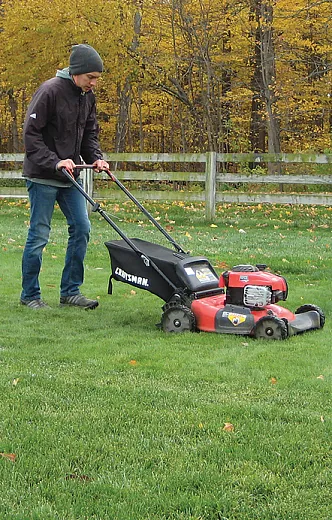
Pesticides also generate N2O emissions. Here again, Braun urges restraint and preaches the “good enough” gospel. A few brown patches or weeds? If the lawn is healthy, resist the urge to apply pesticides and herbicides in pursuit of perfection. “You don’t need to have a 100% pristine turf stand,” he says.
Most research points to mowing as the largest source of GHG in turf management. Slower‐growing varieties can help, as can dialing back on fertilizer and irrigation. Where possible, raise the height of your mower blade. That also helps grass develop a deeper root system, in turn saving on irrigation. “Just a little bit makes a huge difference,” Braun says.
But for the biggest impact, go electric. In a 2022 study Braun cites, researchers compared the emissions of electric and gas mowers. Compared with the 1.3 tons of CO2 equivalents per acre per year for gas, electric mowers emit 0.5 tons if charged off the U.S. grid and zero (at least in the product use phase) if charged from on‐site solar panels. According to the California Air Resources Board, a commercial operator using one backpack leaf blower for one hour generates the same emissions as a car driving 1,100 miles. For that reason, starting next year in the Golden State, newly manufactured engines used in leaf blowers, lawn mowers, and other equipment must by law be zero emission.
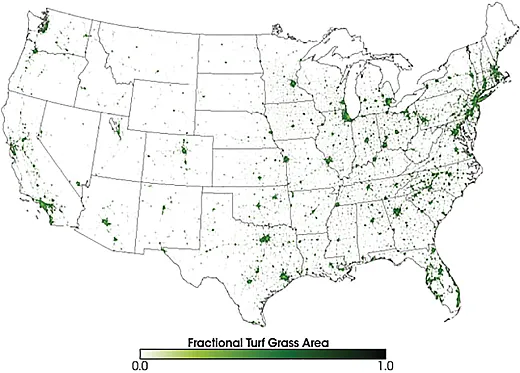
Electric mowing is on the rise in the golf course and sports turf industries, Braun says. “Those are more highly maintained, and there’s more opportunities there to use electric equipment,” he says. “But we’re also starting to see it more in the home lawn sector.”
Recommendations, Reality, and Breeding
Braun’s turfgrass career dates to high school, when he launched a lawncare business that he continued at North Dakota State University. In college he eventually realized, “Oh, I can get my degree in this!” and has been expanding his turf know‐how ever since. On his own 3,500 ft2 lawn, he practices what he preaches: He mows high, fertilizes just once or twice a year, and applies hardly any pesticides.
But convincing others to adopt more sustainable practices can be challenging. Sometimes education is a barrier: Few homeowners took Turfgrass 101, and lawncare is not necessarily intuitive: Turf doesn’t show the same signs of overwatering as other plants, for example, Kopp points out. Money can also be a barrier to investing in new equipment and pricier slow‐release fertilizer.
The golf world has been making strides—and profiting from it. Climate‐change adaptations have saved the industry more than $886 million annually, according to a 2022 CFTM study. But progress is uneven. According to the 2023 GCSAA study, since 2005, the percentage of courses implementing environmental improvements has declined for most categories. On the other hand, they have gained ground in fuel choices, using more solar and less gasoline, for example.
Another mixed bag, according to the report: The percentage of U.S. golf facilities participating in their state’s best management practices increased from 5% in 2015 to 32% in 2021. Yet between 2005 and 2021, the percentage implementing changes associated with energy conservation declined for every category except maintenance equipment.
These shortcomings make advances in turfgrass breeding all the more important. “Always,” Braun says, “the main focus is looking at trying to find a newer cultivar that requires less inputs but can still provide high quality of turf.” A 2023 Crop Science study (https://doi.org/10.1002/csc2.21046) led by Braun found that proper species selection reduces fertilizer and pesticide inputs by more than 50% and that new and improved cultivars of fine fescues require 20 to 30% less inputs than older cultivars of the same species.
In another recent Crop Science study (https://doi.org/10.1002/csc2.20789), scientists demonstrated that planting drought‐resistant grass can save lots of water as long as folks don’t expect emerald perfection. The Purdue University research team’s threshold was “a minimum level of aesthetically pleasing green color,” or at least 70% green grass. Tall fescue and mixtures held up much better than Kentucky bluegrass, they found. Using the more drought‐resistant cultivar, homeowners stand to save 70,000 liters of water annually for the average lawn.
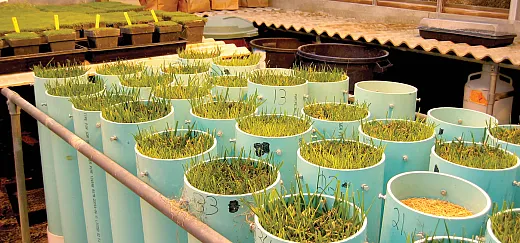
Golf course superintendents have gotten the memo. According to the 2023 GCSAA report, less drought‐tolerant grasses are being replaced by hardier cousins. The projected acres of bermudagrass and Kentucky bluegrass declined between 2005 and 2021 by 7 and 16%, respectively, while tall fescue and zoysiagrass increased by 15 and 54%, respectively.
While there’s a lot of work to do to improve turfgrass cultivars and their management, don’t throw the baby out with the bathwater, urges Kopp. On top of carbon sequestration, turf provides atmospheric cooling, acts as a fire barrier, and offers many other perks.
“I’m just trying to get folks to consider what these plants actually do in the landscape,” Kopp says, “… to get them to consider the science about this plant material before they make blanket characterizations of it as all bad all the time.”
DIG DEEPER
Check out some of the research mentioned in this article:
- Braun, R. C., Straw, C. M., Soldat, D. J., Bekken, M. A. H., Patton, A. J., Lonsdorf, E. V., & Horgan, B. P. (2023). Strategies for reducing inputs and emissions in turfgrass systems. Crop, Forage & Turfgrass Management, 9, e20218. https://doi.org/10.1002/cft2.20218
- Braun, R. C., Watkins, E., Hollman, A. B., & Patton, A. J. (2023). Assessing the fertilizer and pesticide input needs of cool‐season turfgrass species. Crop Science. https://doi.org/10.1002/csc2.21046
- Powlen, J. S., Patton, A. J., Jiang, Y., Fraser, M. L., & Bigelow, C. A. (2022). Response of drought susceptible and resistant Kentucky bluegrass and tall fescue cultivars and mixtures to limited irrigation. Crop Science, 62, 2024– 2034. https://doi.org/10.1002/csc2.20789
- Shaddox, T. W., Unruh, J. B., Johnson, M. E., Brown, C. D., & Stacey, G. (2022). Water use and management practices on U.S. golf courses. Crop, Forage & Turfgrass Management, 8, e20182. https://doi.org/10.1002/cft2.20182
Also of interest is the Pathfinder app from Climate Positive Design (https://climatepositivedesign.com/pathfinder/) and turf management articles by Ross Braun on the Societies’ Decode 6 platform: https://decode6.org/?s=Ross+Braun
Text © . The authors. CC BY-NC-ND 4.0. Except where otherwise noted, images are subject to copyright. Any reuse without express permission from the copyright owner is prohibited.







